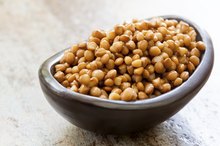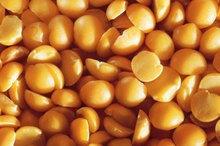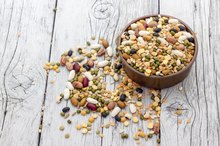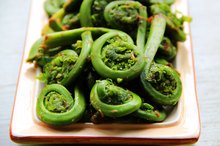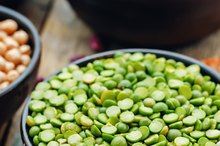Glycemic Index of Lentils
Lentils are the unsung heroes of the nutrition world. Inexpensive and versatile, lentils are rich in protein and fiber but low in fat. They are relatively low in calories and a good source of vitamins and minerals. As a low glycemic index, or GI, food, lentils are also an ideal source of slow-burning energy that may have additional benefits to human health, says the University of Sydney, Australia 1.
Glycemic Index
The glycemic index, or GI, is a ranking of carbohydrate-rich foods on a scale of 0 to 100 according to the degree they influence blood glucose levels after consumption 1. High GI foods have a score of 70 or greater and cause a quick rise in blood glucose. Low GI foods are ranked 55 or lower due to their slower release of energy. A diet based on low glycemic index foods may help with weight control and heart health, says a 2007 Cochrane Intervention Review.
- The glycemic index, or GI, is a ranking of carbohydrate-rich foods on a scale of 0 to 100 according to the degree they influence blood glucose levels after consumption 1.
- A diet based on low glycemic index foods may help with weight control and heart health, says a 2007 Cochrane Intervention Review.
Rankings
Lentils & Vitamin K
Learn More
Dried lentils come in a variety of colors ranging from small green lentils to orange split lentils to whole brown lentils. According to the University of Sydney's glycemic index database of foods, all lentils are ranked as low glycemic index 1. A 150 g serving of dried split red lentils, boiled, has a GI of 21. The glycemic index of dried green lentils, boiled, varies from 22 to 37 1. Canned lentils have a slightly higher GI with canned brown lentils and canned green lentils at 42 and 52, respectively.
Other Health Benefits
In addition to being a low GI food, lentils have many other health benefits. Lentils are a low-fat source of protein; one cup of cooked lentils contains 18 grams of protein. As an excellent source of fiber, lentils provide insoluble fiber to aid bowel regularity and soluble fiber to benefit heart health. Lentils are also rich in important vitamins and minerals such as folate, potassium, iron, magnesium and zinc.
- In addition to being a low GI food, lentils have many other health benefits.
- Lentils are a low-fat source of protein; one cup of cooked lentils contains 18 grams of protein.
Selection
Allergy to Lentils
Learn More
Lentils can be bought dried or canned. Supermarkets sell lentils but an ethnic market or health-food store may have a greater selection from which to choose. Dried lentils are sold in prepackaged bags or in the bulk-bin area. Once purchased, dried lentils keep indefinitely in an airtight container if kept in a cool, dry place. Canned lentils are more convenient because they do not require any cooking before use, but they contain more sodium than their dried counterparts.
- Lentils can be bought dried or canned.
- Dried lentils are sold in prepackaged bags or in the bulk-bin area.
Uses
Unlike dried beans, which have to be soaked before cooking, lentils can be cooked immediately. This makes them a convenient staple to keep in the kitchen. With their subtle flavor and texture, they add interest to a variety of dishes. Use red or brown lentils to replace or extend ground beef in recipes. Add lentils to soups or stews to thicken and add body. Mix French green lentils with seasonal vegetables and vinaigrette for a side salad. Puree cooked lentils with spices to make dal or to use as an alternative spread to hummus.
- Unlike dried beans, which have to be soaked before cooking, lentils can be cooked immediately.
- Mix French green lentils with seasonal vegetables and vinaigrette for a side salad.
Related Articles
References
- University of Sydney: Glycemic Index
- USDA National Nutrient Database For Standard Reference
- Lentils, dry, cooked, fat not added in cooking. USDA FoodData Central. Updated April 1, 2019.
- Abeysekara S, Chilibeck PD, Vatanparast H, Zello GA. A pulse-based diet is effective for reducing total and LDL-cholesterol in older adults. Br J Nutr. 2012;108 Suppl 1:S103-10. doi:10.1017/s0007114512000748
- Ganesan K, Xu B. Polyphenol-Rich Lentils and Their Health Promoting Effects. Int J Mol Sci. 2017;18(11):2390. Published 2017 Nov 10. doi:10.3390/ijms18112390
- Polak R, Phillips EM, Campbell A. Legumes: Health Benefits and Culinary Approaches to Increase Intake. Clin Diabetes. 2015;33(4):198–205. doi:10.2337/diaclin.33.4.198
- Ha V, Sievenpiper J, de Souza R et al. Effect of dietary pulse intake on established therapeutic lipid targets for cardiovascular risk reduction: a systematic review and meta-analysis of randomized controlled trials. Can Med Assoc J. 2014;186(8):E252-E262. doi:10.1503/cmaj.131727
- Sievenpiper JL, Kendall CW, Esfahani A, et al. Effect of non-oil-seed pulses on glycaemic control: a systematic review and meta-analysis of randomised controlled experimental trials in people with and without diabetes. Diabetologia. 2009;52(8):1479-95. doi:10.1007/s00125-009-1395-7
- Rebello CJ, Greenway FL, Finley JW. A review of the nutritional value of legumes and their effects on obesity and its related co-morbidities. Obes Rev. 2014;15(5):392-407. doi:10.1111/obr.12144
- Variety of lentil proteins makes recommendations on avoidance difficult. American Academy of Allergy, Asthma, and Immunology. Published July 24, 2015.
- Legumes (Including Pulses). Anaphylaxis Campaign. Published March 2019.
- Jensen K, Ni Y, Panagiotou G, Kouskoumvekaki I. Developing a molecular roadmap of drug-food interactions. PLoS Comput Biol. 2015;11(2):e1004048. Published 2015 Feb 10. doi:10.1371/journal.pcbi.1004048
- Ndidi US, Ndidi CU, Olagunju A, Muhammad A, Billy FG, Okpe O. Proximate, Antinutrients and Mineral Composition of Raw and Processed (Boiled and Roasted) Sphenostylis stenocarpa Seeds from Southern Kaduna, Northwest Nigeria. ISRN Nutr. 2014;2014:280837. Published 2014 Mar 16. doi:10.1155/2014/280837
- Anti-nutritional Factors. U.S. National Library of Medicine.
- Before You Toss Food, Wait. Check It Out! U.S. Department of Agriculture.
Writer Bio
Kristen White started writing professionally in 2004. She has written for the websites New Farm and Aspire for Life, and for New Zealand's Healthy Food Guide. She is a registered dietitian with clinical experience in weight management and diabetes. White holds a Bachelor of Science in nutrition from Penn State University, and a Master of Science in agronomy from the University of Minnesota.
